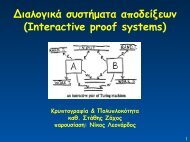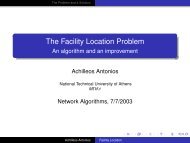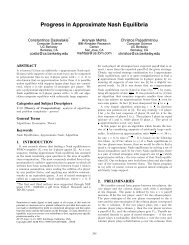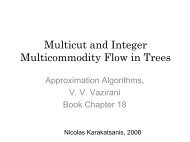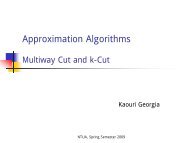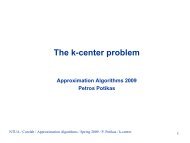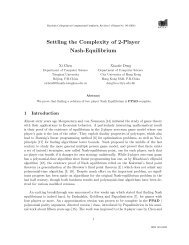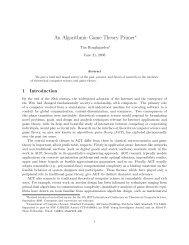A Simple and Efficient Union-Find-Delete Algorithm - Corelab
A Simple and Efficient Union-Find-Delete Algorithm - Corelab
A Simple and Efficient Union-Find-Delete Algorithm - Corelab
Create successful ePaper yourself
Turn your PDF publications into a flip-book with our unique Google optimized e-Paper software.
A <strong>Simple</strong> <strong>and</strong> <strong>Efficient</strong><br />
<strong>Union</strong>-<strong>Find</strong>-<strong>Delete</strong><br />
<strong>Algorithm</strong><br />
Amir Ben-Amram,<br />
Simon Yoffe<br />
ACAC<br />
Athens 2010
<strong>Union</strong> <strong>Find</strong><br />
data structure<br />
Maintain a collection of disjoint sets under the<br />
operations:<br />
Makeset(a) – create new set for element a<br />
<strong>Union</strong>(A, B) – destructive union of sets A <strong>and</strong> B<br />
<strong>Find</strong>(a) – find the set containing a
<strong>Union</strong> <strong>Find</strong> <strong>Delete</strong><br />
data structure<br />
Maintain a collection of disjoint sets under the<br />
operations:<br />
Makeset(a) – create new set for element a<br />
<strong>Union</strong>(A, B) – destructive union of sets A <strong>and</strong> B<br />
<strong>Find</strong>(a) – find the set containing a<br />
<strong>Delete</strong>(a) – remove a from its containing set
The classic data structure<br />
Represent each set A as rooted tree T A<br />
<strong>Union</strong> links the root of the shallower tree to the<br />
root of the taller tree (by rank)<br />
Rank 1<br />
0<br />
9<br />
1<br />
Rank 0<br />
5 3 6<br />
Rank 0 Rank 0 Rank 0<br />
7<br />
Rank 2
The classic data structure<br />
Represent each set A as rooted tree T A<br />
<strong>Union</strong> links the root of the shallower tree to the<br />
root of the taller tree (by rank)<br />
Rank 2<br />
Rank 1<br />
7<br />
0<br />
9<br />
1<br />
Rank 0<br />
5 3 6<br />
Rank 0 Rank 0 Rank 0<br />
O(1)
<strong>Find</strong> climbs from the provided element up to<br />
the root <strong>and</strong> returns the root as the set<br />
identifier<br />
0<br />
7<br />
3<br />
5<br />
1<br />
6<br />
9
<strong>Find</strong> climbs from the provided element up to<br />
the root <strong>and</strong> returns the root as the set<br />
identifier<br />
0<br />
7<br />
3<br />
5<br />
1<br />
6<br />
9<br />
O(log(n))
To increase the amortized efficiency of the find<br />
operation we perform path compression<br />
0<br />
7<br />
3<br />
5<br />
1<br />
6<br />
9<br />
Link all the nodes in the path directly to the root
To increase the amortized efficiency of the find<br />
operation we perform path compression<br />
0<br />
7<br />
3<br />
5<br />
1<br />
6<br />
9<br />
O(α(n)) amortized<br />
Link all the nodes in the path directly to the root
These results go back to...<br />
• R.E. Tarjan. Efficiency of good but not linear<br />
set union algorithm. Journal of the ACM,<br />
22:215-225, 1975<br />
• R.E. Tarjan <strong>and</strong> Jan van Leeuwen. Worst-case<br />
analysis of set union algorithms. Journal of the<br />
ACM, 31(2):245-281, 1984<br />
• These works did not consider delete
Purpose of this talk:<br />
Describe a simple <strong>and</strong> efficient way to<br />
incorporate the delete operation.<br />
Goals:<br />
- <strong>Delete</strong> operation in constant time<br />
- Other operations preserve their current<br />
efficiency (time <strong>and</strong> space)
Applications<br />
• Implementing meldable priority queues (Haim<br />
Kaplan, Nira Shafrir, <strong>and</strong> Robert Endre Tarjan SODA<br />
2002)<br />
• Implementing uniqueness <strong>and</strong> ownership transfer in<br />
the universe type system (Yoshimi Takano 2007)
<strong>Delete</strong> operation<br />
Deleting a leaf node is easy (constant time)<br />
0<br />
5 3<br />
A problem arises when trying to delete a non-leaf<br />
node<br />
0<br />
5 3
<strong>Delete</strong> operation<br />
Deleting a leaf node is easy (constant time)<br />
0<br />
3<br />
A problem arises when trying to delete a non-leaf<br />
node<br />
0<br />
5 3
Possible Solution<br />
<strong>Find</strong> a leaf, switch the elements between the<br />
nodes <strong>and</strong> delete the leaf<br />
50<br />
05 3
Possible Solution<br />
<strong>Find</strong> a leaf, switch the elements between the<br />
nodes <strong>and</strong> delete the leaf<br />
5<br />
0<br />
3
Possible Solution<br />
<strong>Find</strong> a leaf, switch the elements between the<br />
nodes <strong>and</strong> delete the leaf<br />
How to find a leaf?<br />
The answer is that not that simple<br />
5<br />
3
Problems in <strong>Find</strong>ing a Leaf<br />
• The straight-forward idea is to maintain a leaf<br />
collection<br />
• Each node should have some kind of a link to<br />
the leaf collection<br />
• The problem is how to h<strong>and</strong>le those links<br />
during updates<br />
• The straight-forward ideas don’t work in<br />
constant time
Previous Work<br />
• H. Kaplan, N. Shafrir, R.E. Tarjan: <strong>Union</strong>-<strong>Find</strong><br />
with deletions. SODA 2002<br />
• S. Alstrup, I.L. Gørtz, T. Rauhe, M. Thorup,<br />
U. Zwick: <strong>Union</strong>-<strong>Find</strong> with Constant Time<br />
Deletions, ICALP 2005
• The solution instead of finding a leaf uses<br />
vacant nodes (empty nodes)<br />
• Constant time "tidy" <strong>and</strong> "local compress"<br />
operations for preserving efficiency<br />
• Controlling the amount of the vacant nodes<br />
0<br />
7<br />
3<br />
5<br />
1<br />
6<br />
9
• The solution instead of finding a leaf uses<br />
vacant nodes (empty nodes)<br />
• Constant time "tidy" <strong>and</strong> "local compress"<br />
operations for preserving efficiency<br />
• Controlling the amount of the vacant nodes<br />
0<br />
7<br />
3<br />
5<br />
6<br />
9
• The solution instead of finding a leaf uses<br />
vacant nodes (empty nodes)<br />
• Constant time "tidy" <strong>and</strong> "local compress"<br />
operations for preserving efficiency<br />
• Controlling the amount of the vacant nodes<br />
0<br />
7<br />
3<br />
5<br />
6<br />
9
• The solution instead of finding a leaf uses<br />
vacant nodes (empty nodes)<br />
• Constant time "tidy" <strong>and</strong> "local compress"<br />
operations for preserving efficiency<br />
• Controlling the amount of the vacant nodes<br />
0<br />
7<br />
3<br />
5<br />
6<br />
9
Our Solution<br />
<strong>Find</strong>ing a leaf in a constant worst-case time<br />
To accomplish that we extend the data structure<br />
as follows:<br />
• Each node holds an ordered doubly linked list<br />
of its children<br />
• The root holds a doubly linked list of a non leaf<br />
children<br />
• Each tree holds a cyclic doubly linked list of the<br />
tree nodes in right-to-left DFS order
Tree Nodes in DFS Order<br />
The predecessor of a given node can be one of<br />
two:<br />
• The parent node in the tree<br />
DFS<br />
0<br />
3<br />
5<br />
50<br />
05 3
• The leftmost leaf in the sub tree of the right<br />
sibling of the given node<br />
DFS<br />
7<br />
9<br />
1<br />
6<br />
8<br />
0<br />
3<br />
5<br />
0<br />
5 3<br />
8<br />
7<br />
1<br />
6<br />
9
• The predecessor is a parent or a leaf<br />
DFS<br />
50<br />
0<br />
3<br />
6 05 3<br />
4<br />
8<br />
8 4 6<br />
5<br />
• If it is a parent we can examine the left sibling<br />
of the node<br />
DFS<br />
50<br />
0<br />
3<br />
6 05 3<br />
4<br />
8<br />
8 4 6<br />
5
Full or Reduced Trees<br />
We maintain certain invariants to achieve the<br />
desired efficiency. Every tree will be either<br />
• Full – each node is either a leaf of rank 0, or a<br />
parent with at least three children<br />
7<br />
0<br />
1<br />
9<br />
Rank 0<br />
5 2 3 8 4 6<br />
Rank 0 Rank 0
or<br />
• Reduced – a single node of rank 0,<br />
• or a root of rank 1 with leaves of rank 0<br />
Rank 1<br />
0<br />
Rank 0<br />
or<br />
7<br />
0 3 1 5 9<br />
Rank 0<br />
Rank 0 Rank 0
Implementing <strong>Union</strong><br />
One of the trees is of size < 4 :<br />
Hang all its nodes on the other root<br />
T B<br />
0<br />
7<br />
T A<br />
5<br />
3<br />
1<br />
6<br />
9
Implementing <strong>Union</strong><br />
One of the trees is of size < 4 :<br />
Hang all its nodes on the other root<br />
Rank 0<br />
0<br />
7<br />
T A<br />
5<br />
Rank 0<br />
3<br />
Rank 0<br />
1<br />
6<br />
9
Both trees are of size ≥ 4 :<br />
<strong>Union</strong> by rank<br />
Update our additional lists<br />
DFS<br />
7<br />
9<br />
6<br />
1<br />
1<br />
7<br />
6<br />
T A<br />
9<br />
TB<br />
0<br />
5 2 3<br />
DFS<br />
0<br />
3<br />
2<br />
5
Both trees are of size ≥ 4 :<br />
<strong>Union</strong> by rank<br />
Update our additional lists<br />
DFS<br />
7<br />
0<br />
3<br />
2<br />
5<br />
9<br />
6<br />
1<br />
1<br />
T A<br />
7<br />
0<br />
6 9<br />
5 2 3
Implementing <strong>Find</strong><br />
• Instead of path compression we use path<br />
splitting [Tarjan <strong>and</strong> van Leeuwen]<br />
• Each node in the path is moved from its<br />
parent to its gr<strong>and</strong>-parent<br />
• If the parent now has less than three children<br />
we move them as well<br />
0<br />
7<br />
1<br />
9<br />
5 2 3 8 4<br />
6
Implementing <strong>Find</strong><br />
• Instead of path compression we use path<br />
splitting [Tarjan <strong>and</strong> van Leeuwen]<br />
• Each node in the path is moved from its<br />
parent to its gr<strong>and</strong>-parent<br />
• If the parent now has less than three children<br />
we move them as well<br />
0<br />
7<br />
1<br />
9<br />
5 2 3 8 4<br />
6
Implementing <strong>Find</strong><br />
• Instead of path compression we use path<br />
splitting [Tarjan <strong>and</strong> van Leeuwen]<br />
• Each node in the path is moved from its<br />
parent to its gr<strong>and</strong>-parent<br />
• If the parent now has less than three children<br />
we move them as well<br />
0<br />
7<br />
1<br />
9<br />
5 2 3 8 4<br />
6
Fixing The DFS Order<br />
• If node x has a left sibling (l), it means that the<br />
sub tree that starts at x is represented in the<br />
DFS order by segment [x, l)<br />
• It is simple to disconnect the segment <strong>and</strong> insert<br />
it before the parent of x in the DFS order DFS<br />
7<br />
7<br />
1<br />
6<br />
1<br />
x<br />
2<br />
l<br />
x<br />
5 3<br />
6<br />
2<br />
3<br />
5<br />
l<br />
…
Fixing The DFS Order<br />
• If node x has a left sibling (l), it means that the<br />
sub tree that starts at x is represented in the<br />
DFS order by segment [x, l)<br />
• It is simple to disconnect the segment <strong>and</strong> insert<br />
it before the parent of x in the DFS order DFS<br />
7<br />
7<br />
1<br />
6<br />
1<br />
l<br />
…<br />
l<br />
6
Fixing The DFS Order<br />
• If node x has a left sibling (l), it means that the<br />
sub tree that starts at x is represented in the<br />
DFS order by segment [x, l)<br />
• It is simple to disconnect the segment <strong>and</strong> insert<br />
it before the parent of x in the DFS order<br />
7<br />
l<br />
1<br />
6<br />
5<br />
x<br />
3<br />
2<br />
DFS<br />
7<br />
x<br />
2<br />
3<br />
5<br />
1<br />
6<br />
l<br />
…
• If node x is the leftmost child of its parent,<br />
we do not have to change the DFS order<br />
at all<br />
7<br />
x<br />
1<br />
8<br />
6<br />
5<br />
3<br />
2<br />
DFS<br />
7<br />
1<br />
6<br />
8<br />
x<br />
2<br />
3<br />
5<br />
…
• If node x is the leftmost child of its parent,<br />
we do not have to change the DFS order<br />
at all<br />
7<br />
x<br />
1<br />
8<br />
6<br />
5<br />
3<br />
2<br />
DFS<br />
7<br />
1<br />
6<br />
8<br />
x<br />
2<br />
3<br />
5<br />
…
Implementing <strong>Delete</strong><br />
Tree is of size ≤ 4 :<br />
Rebuild the tree in to reduced from<br />
7<br />
1<br />
9<br />
6
Implementing <strong>Delete</strong><br />
Tree is of size ≤ 4 :<br />
Rebuild the tree in to reduced from<br />
7<br />
1<br />
6
Tree of size > 4 :<br />
<strong>Find</strong> a leaf, switch elements with the leaf node<br />
<strong>Delete</strong> the leaf node<br />
Update additional lists<br />
If the tree is not reduced as the result of the<br />
deletion apply local rebuild to the parent of<br />
the deleted node (or the root)
Local Rebuild<br />
If node y is not the root, move 2 leftmost children<br />
of y to its parent<br />
7<br />
1<br />
y<br />
8<br />
6<br />
5<br />
3<br />
2<br />
If less than 3 children remain, move the rest of<br />
the children as well
Local Rebuild<br />
If node y is not the root, move 2 leftmost children<br />
of y to its parent<br />
7<br />
1<br />
y<br />
8<br />
6<br />
5<br />
3<br />
2<br />
If less than 3 children remain, move the rest of<br />
the children as well
Local Rebuild<br />
If node y is not the root, move 2 leftmost children<br />
of y to its parent<br />
7<br />
1<br />
y<br />
8<br />
6<br />
5<br />
3<br />
2<br />
If less than 3 children remain, move the rest of<br />
the children as well
If node y is the root <strong>and</strong> node c is a non-leaf child<br />
of y, move three leftmost children of c to y<br />
y<br />
c<br />
1<br />
5<br />
3<br />
2<br />
If less than 3 children remain, move the rest of<br />
the children as well
If node y is the root <strong>and</strong> node c is a non-leaf child<br />
of y, move three leftmost children of c to y<br />
y<br />
c<br />
1<br />
5<br />
3<br />
2<br />
If less than 3 children remain, move the rest of<br />
the children as well
If node y is the root <strong>and</strong> node c is a non-leaf child<br />
of y, move three leftmost children of c to y<br />
y<br />
c<br />
1<br />
5<br />
3<br />
2<br />
If less than 3 children remain, move the rest of<br />
the children as well
Analysis<br />
Our asymptotic worst case <strong>and</strong> amortized<br />
complexity is similar to that of Alstrup et al.<br />
We actually reuse parts of their analysis.<br />
The notable difference is a conceptual<br />
simplification (no vacant nodes) <strong>and</strong> a much<br />
simpler “local compression”<br />
+ a simplified analysis (with smaller constant<br />
factors)
Future Research<br />
• Can we find a leaf in the sub tree of the node<br />
requested for deletion?<br />
• Can we reduce the memory usage of the data<br />
structure?
E<br />
Thank You




